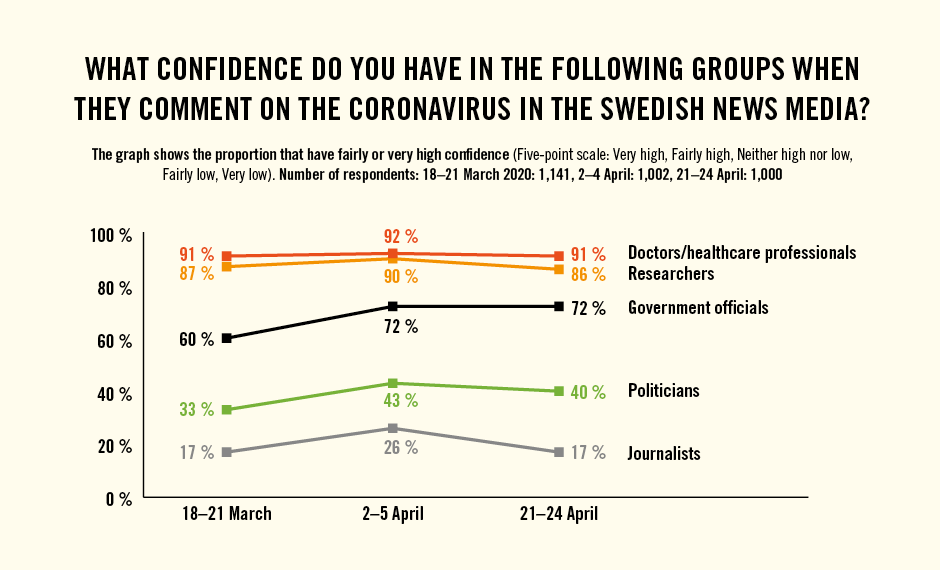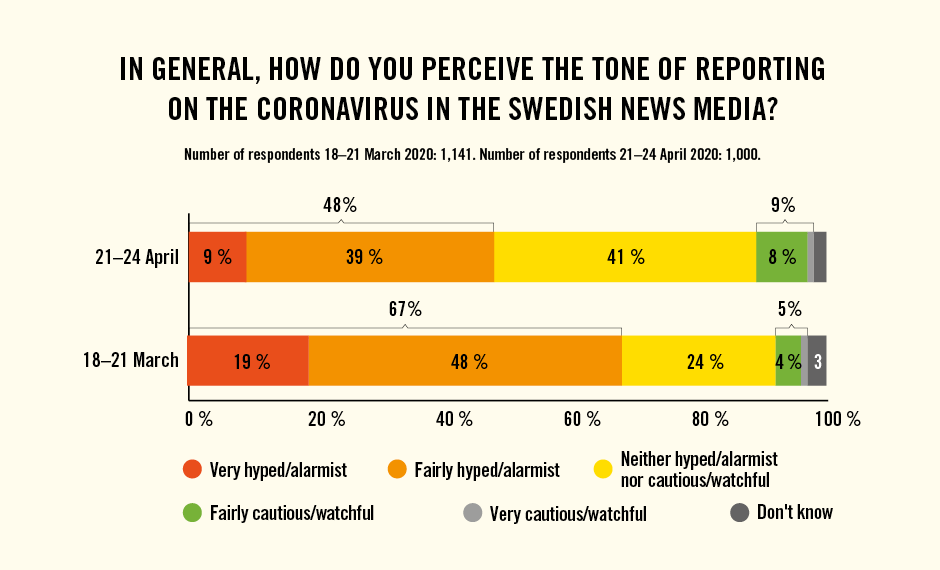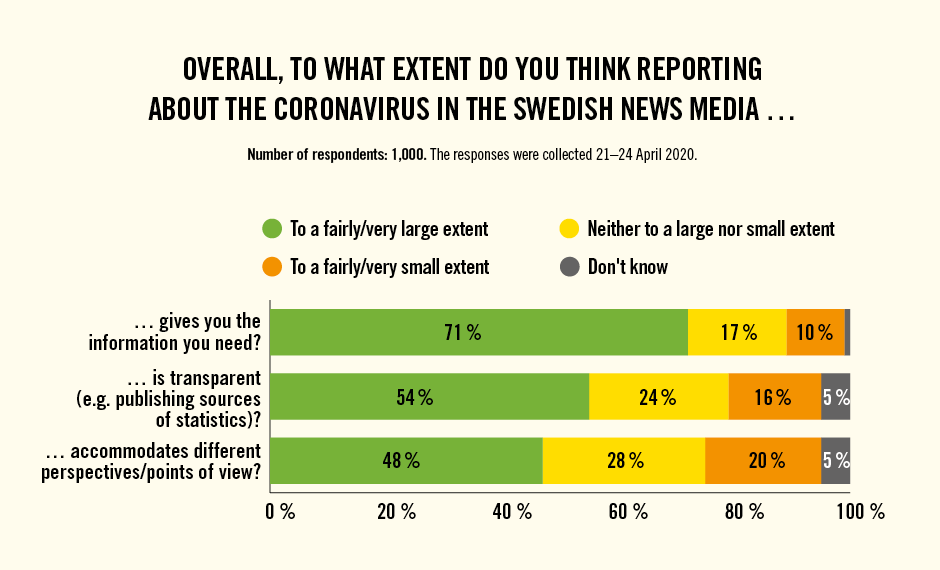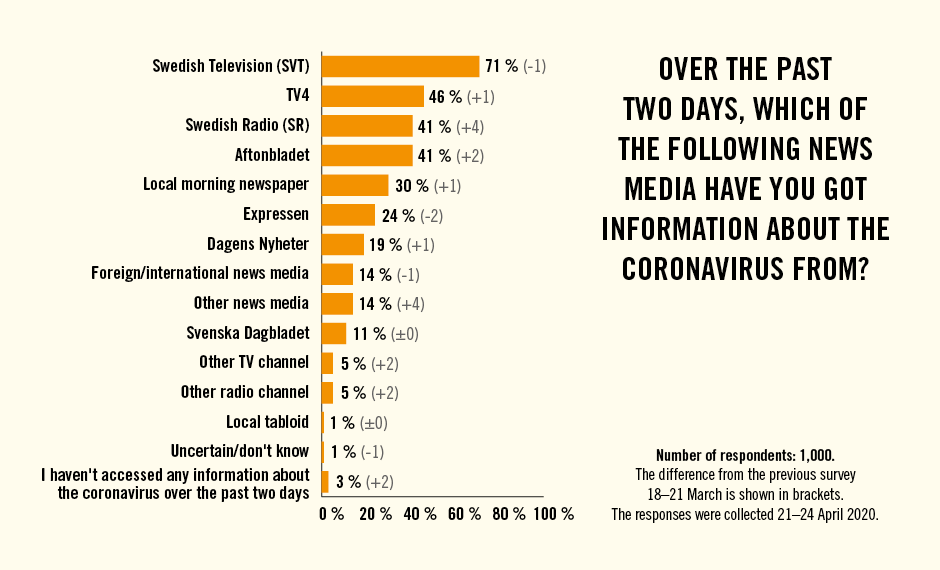The tone of reporting on the coronavirus in Swedish news media is perceived by the Swedish public to be less alarmist now than it was a month ago. Swedes continue to have a high level of confidence in healthcare professionals, researchers and government officials. These are the latest findings of a study being conducted by the Swedish non-profit organisation VA (Public & Science).

In collaboration with researchers at the Karolinska Institute and Södertörn University, VA (Public & Science) is conducting a study of how people are receiving and interpreting information about the coronavirus and the ongoing pandemic. Here we present the findings from the third wave of the study, which was undertaken between 21–24 April 2020.
Highest confidence in healthcare professionals
As in our first and second surveys, Swedes have the highest confidence in doctors /other healthcare professionals and researchers among the different professional groups that comment about the coronavirus in the news media. The strengthening of confidence in government officials seen in the second survey is maintained, with 72 percent of Swedes having fairly or very high confidence in this group. Confidence in other groups also remains at the same level as in the second survey. The exception is journalists, in whom confidence remains at the same level (17 percent) as in the first survey.
Reporting perceived as less hyped
In this most recent survey, a significantly smaller proportion of Swedes perceive the tone of reporting on the coronavirus in the Swedish news media as hyped/alarmist, compared to when it was first measured in March. At that time, two-thirds of Swedes felt that the tone was fairly or very hyped/alarmist, while the corresponding proportion in the latest survey is around half (48 percent). When first measured, the difference between men and women’s perceptions was negligible, but now 53 percent of men perceive the tone to be fairly or very hyped/alarmist, while the corresponding figure among women is 42 percent.

Informative and transparent reporting
The Swedish news media’s coverage of the coronavirus is viewed positively by the majority of Swedes. Seven out of ten (71 percent) believe that the reporting provides them with the information they need to a fairly or very large extent. Among those aged 70 years or older, the corresponding figure is 82 percent, and among younger people (18-29 years) it is 64 percent.
More than half (54 percent) perceive that the news reporting is transparent to a fairly or very large extent, and, for example, publish the sources of statistics. On the other hand, one in six Swedes (16 percent) believes that the news reporting is transparent to a fairly or very small extent. This view is particularly common among those that support the national-conservative Sweden Democrats, of whom 35 percent are of this opinion.
Almost half of Swedes (48 percent) believe that Swedish news media to a fairly or very large extent accommodates different perspectives/points of view in their reporting about the coronavirus. While one in five (20 percent) considers that different perspectives are accommodated to a fairly or very small extent. This opinion is more common among men than among women (24 and 16 percent, respectively), and among supporters of the Sweden Democrats (42 percent).

Swedish Television (SVT) is the most common source of news
The Swedish public predominantly gets its news about the coronavirus from the same news media as it did in our first survey (18-21 March). Swedish Television (SVT) remains the most common source of news – seven out of ten Swedes (71 percent) had got information about the coronavirus from SVT over the preceding two days. This is followed by TV4 (46 percent), Swedish Radio (SR) and the tabloid Aftonbladet (both 41 percent).
The evening tabloids (Aftonbladet, 41 percent and Expressen, 24 percent) and local morning newspapers (30 percent) reach more readers than the larger morning newspapers Dagens Nyheter and Svenska Dagbladet (19 and 11 percent, respectively). The older part of the population (aged 70 and older) consumes more news about the coronavirus from SVT, SR, Svenska Dagbladet and local morning newspapers compared to others, but consumes Aftonbladet to a lesser extent, similar to in the previous survey.

About the survey
The survey was conducted by Kantar Sifo and consisted of 1,000 interviews with a web panel based on random sampling. The interviews were conducted between 21–24 April 2020. The results are weighted based on gender, age and region of residence.
Ongoing studies
In order to monitor the Swedish public’s news consumption, confidence in key professional groups and attitudes towards media reporting over time, we intend to conduct further studies during the course of the pandemic. We also plan to undertake a content analysis of reporting on the coronavirus in the Swedish media in order to map any changes in reporting during different phases, and how this relates to public attitudes during the same time period. Read more about VA’s study.
The study is being conducted with the support of the Anne-Marie and Gustaf Anders Foundation for Media Research, LIF – the Swedish Association of the Pharmaceutical Industry, the Wenner-Gren Foundations and the Swedish Research Council.
